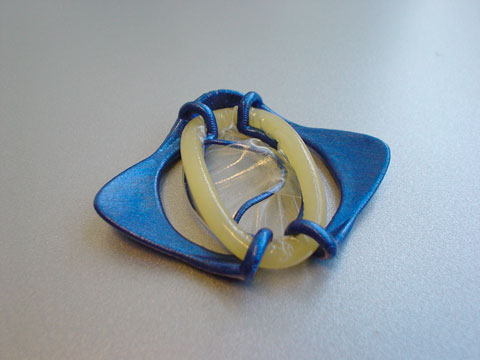Delta and Delft Integraal/Outlook often write about innovative ideas that offer big promises for the future. But what has happened to such ideas a couple years on? What for instance has happened to Wingman?
Delta, 17-11-2005
Never again having to struggle with rubbers. The Delft student company MungosWorks developed a radical new way to put on a condom.
When it’s dark and you’ve had a few drinks, many men struggle to get the condom pack open, and it’s also often frustratingly hard to figure out what side of the rubber is up. Not the best way to stay in the mood for having sex. One night, however, inventor and former student mechanical engineering Adnan Tunovic had enough of this irritating process. The next morning he came up with an idea: Wingman, an inventive condom clip, which has made struggling with rubbers a thing of the past. “The clip is already on the condom when it is still in the package. The clip shows you what side is up, and then all you have to do is unroll it on the penis. This only takes three seconds and you can do it with one hand,” explains Tunovic, who is the director of MungosWorks.
Five years ago Delta was the first to publish an article about Wingman. After that the condom gadget became a media hype. Tunovic appeared on Dutch TV shows like ‘De Wereld Draait Door’ and ‘Hart van Nederland’. Newspapers and magazines like NRC Handelsblad and Der Spiegel wrote about his invention. One of Holland’s best-known players, dj Jean, said he couldn’t wait to use Wingman. Bags full of mail from desperate condom users arrived at the MungosWorks office in Delft.
It was the best possible publicity a product could get to take over the condom market; however, five years later and Wingman is still not on the market. “It’s been very difficult to find an investor”, Tunovic says. “We were close to a deal with a company in 2008.” But the financial crisis made investors hesitant. “Condom suppliers want us to make a series of 100,000 Wingmans. That way people can test it on a large scale and it will show that it makes using a condom so much easier. To make 100,000 Wingmans however we need to create a stamper, buy condoms, set up a semi-automatic assembly line and have Wingman certified.” That will cost 200,000 euro. Nobody yet wants to invest the money to set this up.
Tunovic still believes in his product and is convinced that the clip will be a success. “Every month we get letters about Wingman”, he adds. “I’ve used the prototypes, so I know they work very well. Although I don’t use them anymore, because I got married.
Bij de in aanbouw zijnde proefcentrale van Nuon in Buggenum komt een opstelling waar een Delftse promovendus zich mag uitleven. “We willen dat daar met een heel andere bril naar CO2-afvang wordt gekeken”, zegt development manager Kay Damen van de afdeling Carbon Capture and Storage, de tak van Nuon die zich richt op het afvangen van CO2 en de opslag van het broeikasgas.
Nuon en TNO betalen samen de promovendus die daar nieuwe methoden moet onderzoeken om koolstofdioxide te verwijderen uit syngas – een tussenproduct in energiecentrales.
De aanzet tot het promotieonderzoek is een nieuwe methode om ultieme wasmiddelen te ontdekken waarmee je CO2 kunt ‘losweken’ uit syngas. De methode is in feite niets meer dan een thermodynamisch model waarin je alle fysische vereisten van oplosmiddelen voor CO2-afvang kunt invoeren.
De promovendus, die overigens nog moet worden aangenomen, zal
experimenteren met andere wasvloeistoffen en proberen de omstandigheden
waarbij het CO2-afvangproces plaatsvindt zo goed mogelijk af te stemmen
op de nieuwe wasvloeistoffen.
“Uit het model rolt een soort vingerafdruk van het ideale wasvloeistofmolecuul”, zegt prof.dr.ing. Joachim Gross van de afdeling proces en energie. “Die afdruk kun je gebruiken om uit de honderden duizenden bestaande oplosmiddelen het beste wasmiddel – diegene die het meeste lijkt op het modelmolecuul – te kiezen.”
Student Klaas Steur (Technische Natuurwetenschappen) ontwikkelde het model voor zijn afstuderen. Hij sleepte er vorige week een Europese prijs voor innovaties in energiesystemen mee in de wacht, de European Talent Award for Innovative Energy Systems 2009.
“Het model heeft grote potentie”, zegt Gross, die de student begeleidde en die tevens betrokken is bij het onderzoek met Nuon. “Het afvangen van koolstofdioxide bij energiecentrales verloopt nog ontzettend inefficiënt. Bij kolencentrales verlies je zo dertig procent aan rendement. Bij gascentrales is het verlies minder, maar nog steeds significant. Wereldwijd wordt het broeikasgas dan ook nog nauwelijks afgevangen.”



Comments are closed.